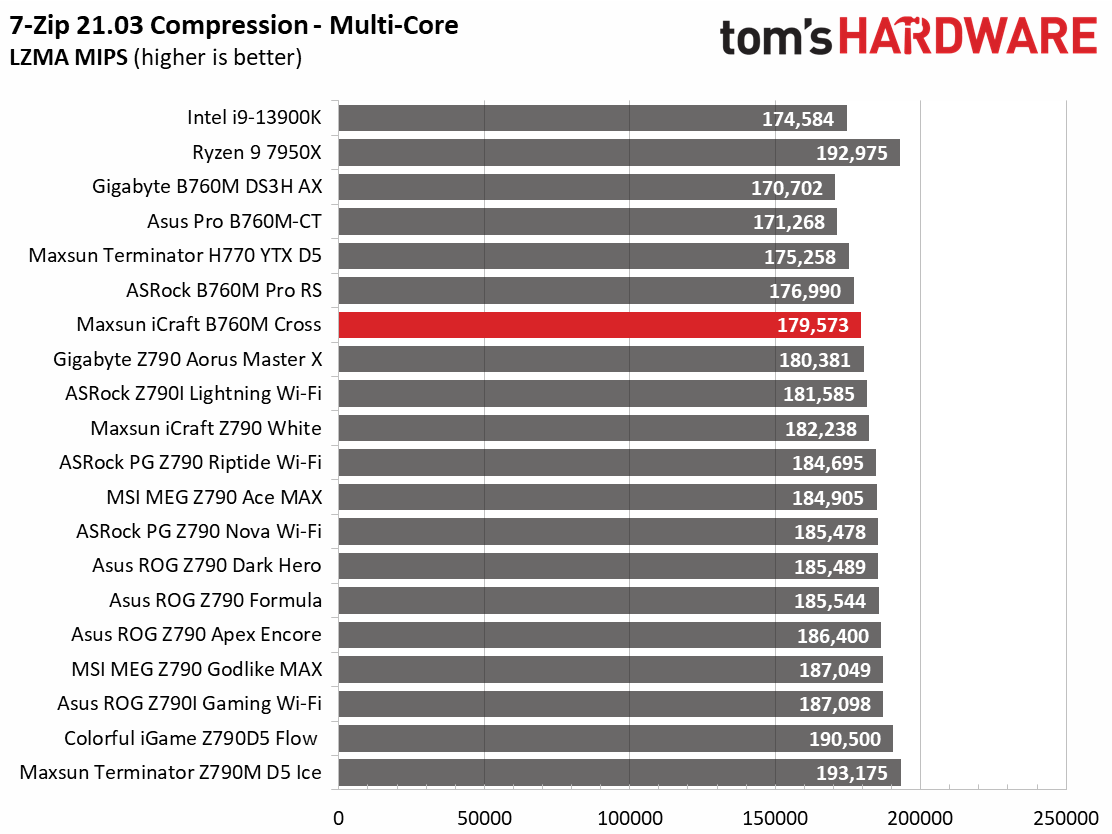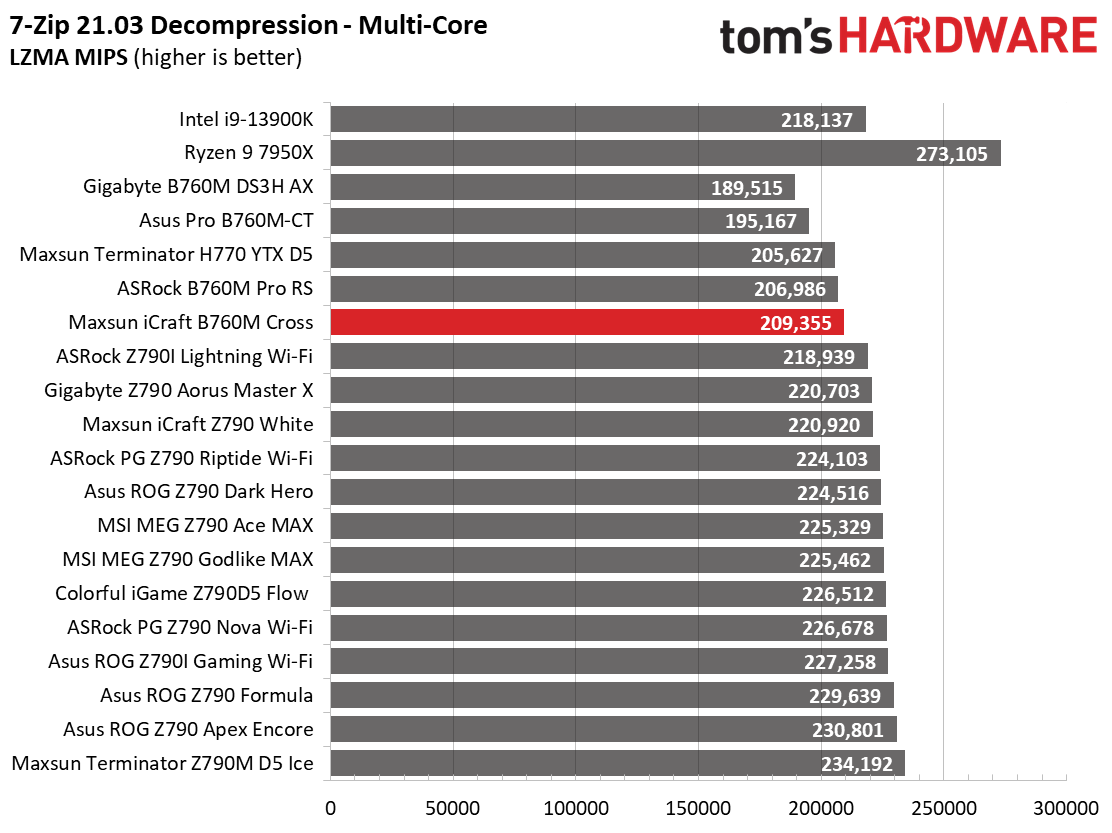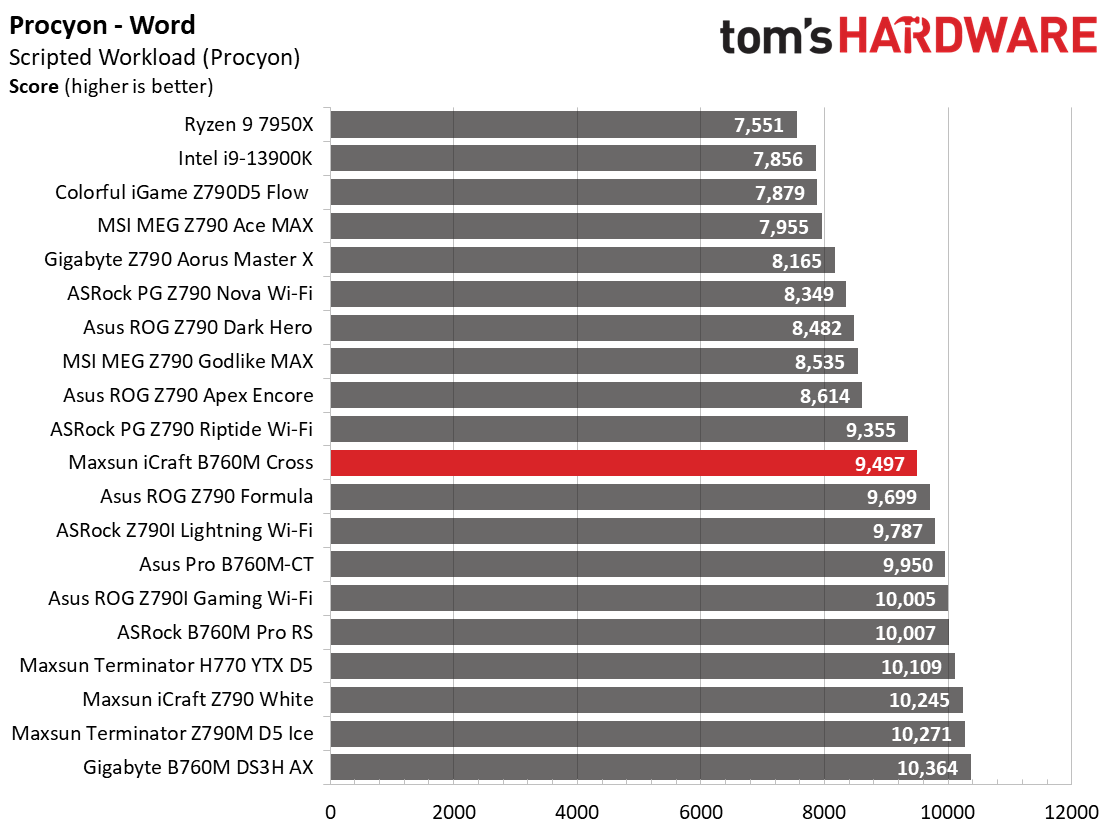Why you can trust Tom's Hardware
Our standard benchmarks and power tests are performed using the CPU’s stock frequencies (including any default boost/turbo) with all power-saving features enabled. We set optimized defaults in the BIOS and the memory by enabling the XMP profile. For this baseline testing, the Windows power scheme is set to Balanced (default) so the PC idles appropriately.
Synthetic Benchmarks
Synthetics provide a great way to determine how a board runs, as identical settings should produce similar performance results. Turbo boost wattage and advanced memory timings are places where motherboard makers can still optimize for stability or performance, though, and those settings can impact some testing.


















Performance in the synthetic benchmarks was average to below average across the board. We see performance like this because the board only allows a maximum of 225W to the CPU, regardless of what you set.
Timed Applications




The timed applications told a similar story, with the LAME and Corona results being just below average. Handbrake results were slower than most, but not woefully so like some of the other budget B760M boards we tested.
3D Games and 3DMark




Starting with the launch of Zen 4, we shifted our test games from F1 21 to F1 22 while keeping Far Cry 6. We run the games at 1920x1080 resolution using the Ultra preset (details listed above). As the resolution goes up, the CPU tends to have less impact. The goal with these settings is to determine if there are differences in performance at the most commonly used (and CPU/system bound) resolution with settings most people use or strive for (Ultra). We expect the difference between boards in these tests to be minor, with most falling within the margin of error differences. We’ve also added a minimum FPS value, which can affect your gameplay and immersion experience.
Interestingly, this board was slower in 3DMark tests and Far Cry 6, but F1 22 was one of the fastest results. There’s nothing to be concerned about in gaming unless the title uses many cores and threads, and even then, you wouldn’t notice the difference without a counter on the screen.
Overclocking
Generation after generation, overclocking headroom has been shrinking with both Intel and AMD processors, with motherboard partners pushing the limits to set themselves apart from the plethora of options available to the consumer. With the overclocking headroom all but gone, we’ve left things at stock for cores but will push the Integrated Memory Controller (IMC) for faster RAM. Remember, for 14th-gen CPUs, the maximum stock spec for memory is DDR5-5600. We have a DDR5-7200 kit and a DDR5-8000 kit in-house to test the higher speeds.
Get Tom's Hardware's best news and in-depth reviews, straight to your inbox.
The B760M worked well with our DDR5-6000 base and DDR5-7200 kits. This range is easily in the sweet spot for price to performance. That said, I’m not really sure what the maximum speed is for this board. The website lists DDR5-7600 in the overview, but the specs say DDR5-7200. Your best bet is to stick to the memory QVL list for best results. Remember, you can’t really overclock the CPU on this platform, but it has headroom for memory.
Power Consumption / VRM Temperatures
We used AIDA64’s System Stability Test with Stress CPU, FPU, Cache, and Memory enabled for power testing, using the peak power consumption value. The wattage reading is from the wall via a Kill-A-Watt meter to capture the entire PC (minus the monitor). The only variable that changes is the motherboard; all other parts remain the same. Please note we moved to using only the stock power use/VRM temperature charts. Since the system uses every available degree Celsius, unless you’re using a sub-ambient cooling solution, you’ll use more power and generate more heat using default settings.
Power use was one of the lowest we’ve recorded on the platform. The B760M Cross idled at a low 48W; while under load, it peaked at 328W, the lowest we’ve recorded. We’re seeing such low power use because of the lower CPU limit.


VRM temperatures peaked around 52 degrees Celsius during our stress tests. The VRM heatsink warmed up, but temperatures were easily within spec, especially with the more meager 225W output. I do not doubt that the cooling ecosystem can support more power and keep things running within specifications, but I wouldn’t push it much past the actual 253W limit.
Bottom Line
Maxsun’s iCraft B760M Cross is a solid Micro ATX motherboard. For under $200, you get a generally well-equipped part with a unique white appearance, an anime theme, and even a tiny screen showing off the anime character. RGBs light up the display and strategic parts on the board and help bring some bling to your chassis. On top of that, there’s ample storage with three M.2 sockets and four SATA ports, fast networking with integrated Wi-Fi 6E and 2.5 GbE, and even dual 20 Gbps Type-C ports. Performance on some tests was a bit behind other boards that don’t set lower power limits (peaked at 225W).
All that said, while we like this motherboard, it’s not without drawbacks, and some are significant. First and foremost, the website says that PL1 is set to 253W with PL2 unlimited. This is true; it is set that way. However, we could not reach the advertised value during testing, maxing at 225W. Even changing the values in the BIOS and raising the PL1 to unlimited, the board still peaked at 225W. So, until there is a BIOS update, as far as I can see, you’re locked into that limit.
Also worth mentioning is that the BIOS update with the Intel microcode to prevent premature degradation is not available as of this writing. We’d also like to see a Windows-based utility with more control over the system and a more accurate website (peak memory speeds say DDR5-7200 on one page and DDR5-7600 on another). Last, where’s the manual? Paper manuals are long gone, but you should have a manual available on the website.
Although that feels like a long list of negatives, most of these are minor. The board competes well against the MSI MPG B760M Edge Ti Wi-Fi ($219.99) and the Asus TUF Gaming B760M-BTD Wi-Fi ($219.99), which offer a similar number of ports and connectivity. The most significant difference is that the ecosystem of others is more mature. There are online manuals for those boards, and the web pages don’t have conflicting information. They also all have the latest Intel microcode available, whereas at the time of this writing (mid-September 2024), Maxsun does not. I'd buy the MSI or Asus boards listed, at least until Maxsun releases an updated BIOS with the new Intel microcode.
MORE: Best Motherboards
MORE: How To Choose A Motherboard
MORE: All Motherboard Content

Joe Shields is a staff writer at Tom’s Hardware. He reviews motherboards and PC components.
-
ezst036 Interesting, it has more usable PCIe slots than many (even higher-end) full size ATX boards do.Reply
The choice of a 4x slot is somewhat rare on boards, but that does make it possible to use any number of connectivity cards.
What would be really interesting is if those USB ports were capable of driving a video.


